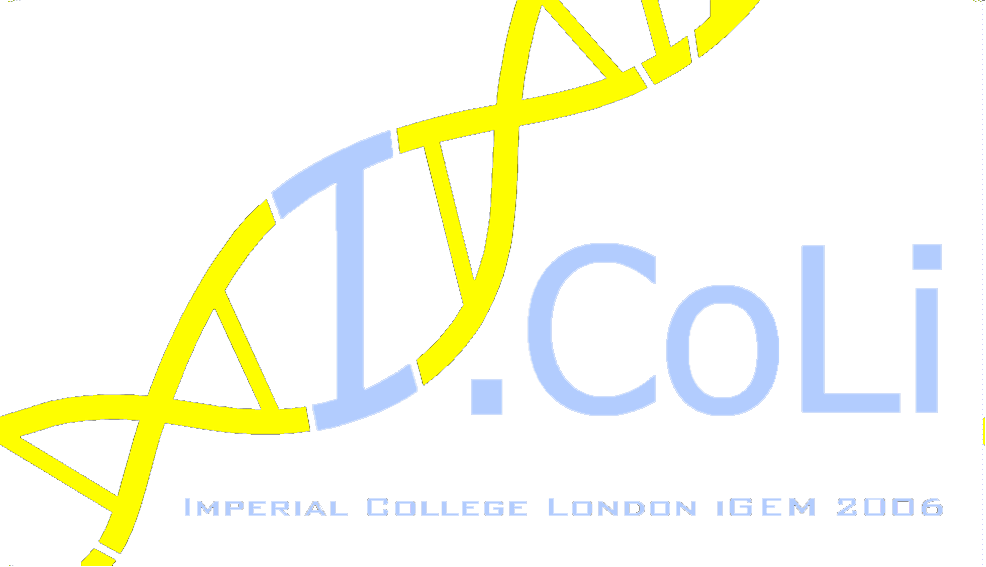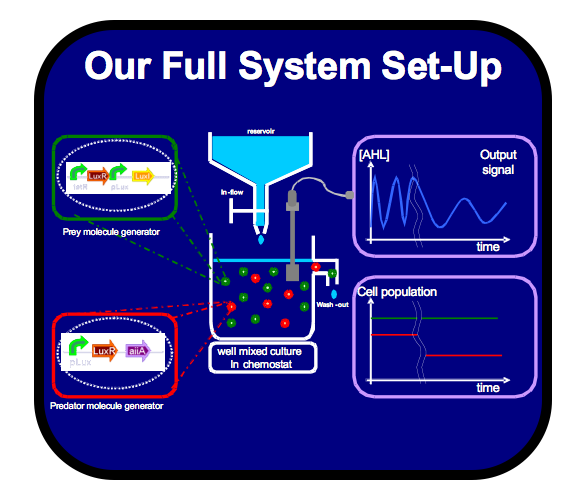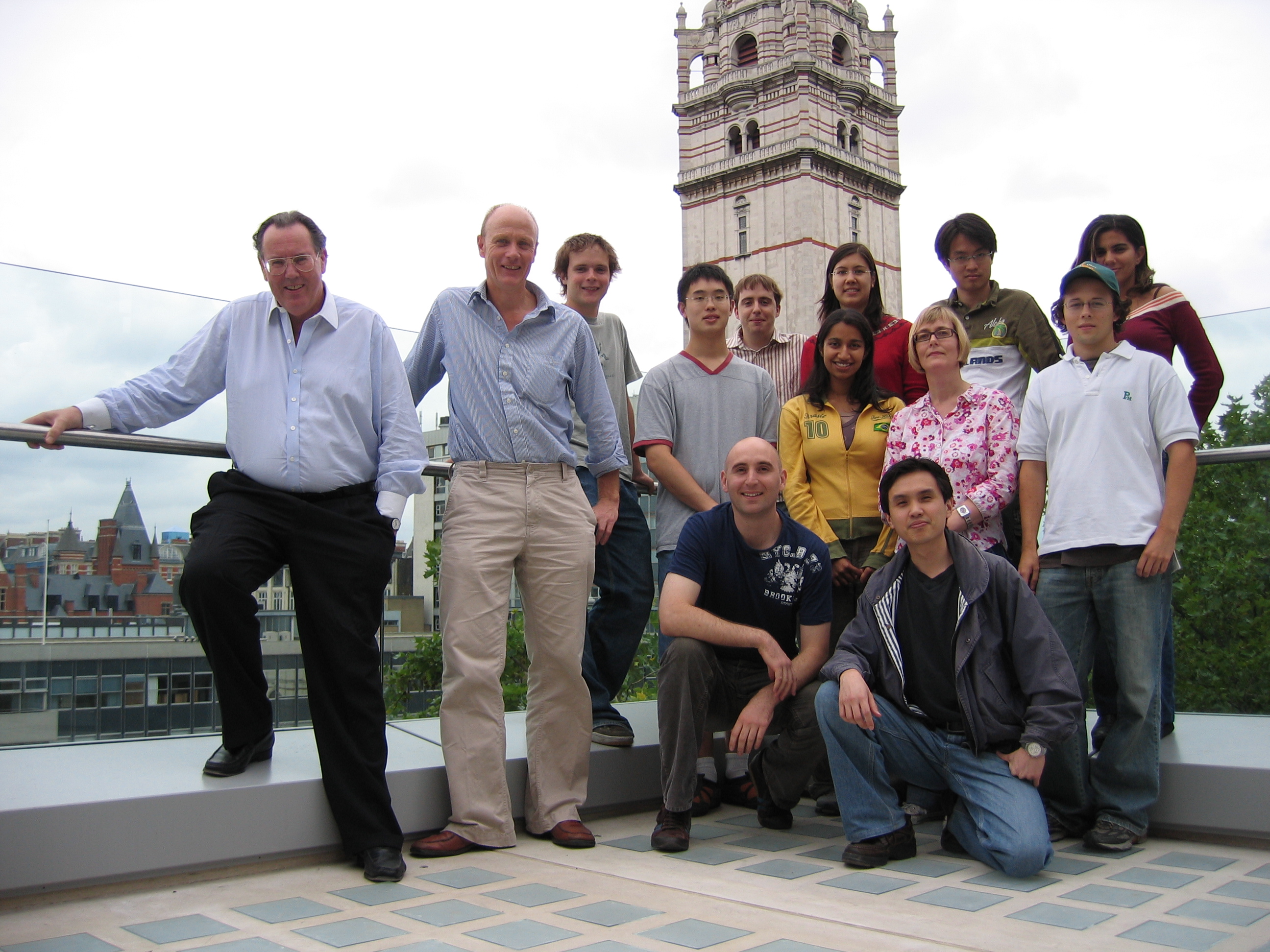Imperial College 2006/Sandbox
From 2006.igem.org
m (→Our Open Documentation) |
m |
||
| Line 10: | Line 10: | ||
{| border="0" width="100%" | {| border="0" width="100%" | ||
|- | |- | ||
| - | |width="20%" style="background:# | + | |width="20%" style="background:#2171B8"|[[Image:LogoFinal2.png|210px|center]] |
| - | |width="40%" style="background:# | + | |width="40%" style="background:#2171B8" | <font face="century gothic" font style="color: #FFFFFF"> <center><u>'''Project Summary:'''</u></center> <br> |
Oscillators are a fundamental building block in many engineering fields and are a widespread phenomenon in biology. Building a biological oscillator is thus a crucial step forward in the field of Synthetic Biology. <br> | Oscillators are a fundamental building block in many engineering fields and are a widespread phenomenon in biology. Building a biological oscillator is thus a crucial step forward in the field of Synthetic Biology. <br> | ||
| - | '''Engineering a Molecular Predation Oscillator''', the iGEM project 2006 of Imperial College London, provides a new approach to create a stable biological oscillator: It follows an engineering-based cycle of specification, design, modelling, implementation and testing/validation. The innovative design of the oscillator relies on predator-prey dynamics based on the Lotka-Volterra model. | + | '''Engineering a Molecular Predation Oscillator''', the iGEM project 2006 of Imperial College London, provides a new approach to create a stable biological oscillator: It follows an engineering-based cycle of specification, design, modelling, implementation and testing/validation. The innovative design of the oscillator relies on predator-prey dynamics based on the Lotka-Volterra model. </font> |
| - | |width="40%" style="background:# | + | |width="40%" style="background:#2171B8" | <font face="century gothic" font style="color: #FFFFFF"> <center><u>'''Achievements:'''</u></center> <br> |
| - | Following the design of the oscillator, a full theoretical analysis of the Lotka-Volterra properties was carried out, which promised the successful outcome of oscillations. Additionally, all components as well as the overall oscillator were modelled such that the behaviour of the system could be predicted. Our team successfully built functional parts, thus providing the building block for the final oscillator. All parts created were experimentally tested and their characterization could be used to feedback information into the modelling. | + | Following the design of the oscillator, a full theoretical analysis of the Lotka-Volterra properties was carried out, which promised the successful outcome of oscillations. Additionally, all components as well as the overall oscillator were modelled such that the behaviour of the system could be predicted. Our team successfully built functional parts, thus providing the building block for the final oscillator. All parts created were experimentally tested and their characterization could be used to feedback information into the modelling. </font> |
| - | + | ||
|} | |} | ||
| Line 59: | Line 58: | ||
==Secondary Projects== | ==Secondary Projects== | ||
| - | {| border="0" width="100%" style="background:# | + | {| border="0" width="100%" style="background:#2171B8" |
|- | |- | ||
| - | ! width="50%" | <big>'''[http://openwetware.org/wiki/IGEM:IMPERIAL/2006/project/popsblocker PoPs Blocker] '''</big>!! width="50%"| <big>'''[http://openwetware.org/wiki/IGEM:IMPERIAL/2006/project/Bio_elec_interface Biological to Electrical Interface]'''</big> | + | ! width="50%" | <big>'''[http://openwetware.org/wiki/IGEM:IMPERIAL/2006/project/popsblocker <font face="century gothic" font style="color: #FFFFFF">PoPs Blocker</font>] '''</big>!! width="50%"| <big>'''[http://openwetware.org/wiki/IGEM:IMPERIAL/2006/project/Bio_elec_interface <font face="century gothic" font style="color: #FFFFFF">Biological to Electrical Interface]</font>'''</big> |
|- | |- | ||
| - | | style="background:# | + | | style="background:#2171B8" width="50%" | |
| - | As a method of controlling the activation of the positive-feedback loop in our predator-prey based oscillator, we successfully created this part, which can be used as a general Pops Blocker: | + | <font face="century gothic" font style="color: #FFFFFF"> As a method of controlling the activation of the positive-feedback loop in our predator-prey based oscillator, we successfully created this part, which can be used as a general Pops Blocker: |
*This part is placed downstream of a promoter and prevents any Pops from the promoter passing through this part | *This part is placed downstream of a promoter and prevents any Pops from the promoter passing through this part | ||
*When an accompanying Cre Recombinase plasmid becomes activated, the enzyme produced will permanently cut a section of DNA from the plasmid containing this part | *When an accompanying Cre Recombinase plasmid becomes activated, the enzyme produced will permanently cut a section of DNA from the plasmid containing this part | ||
| - | *Only then, the polymerase can pass through this part and transcribe downstream genes. | + | *Only then, the polymerase can pass through this part and transcribe downstream genes. </font> |
| - | | style="background:# | + | | style="background:#2171B8" width="50%"| |
We also worked on a Biosensor for measuring AHL concentrations in order to establish a Biological to Electrical Interface this summer. | We also worked on a Biosensor for measuring AHL concentrations in order to establish a Biological to Electrical Interface this summer. | ||
*Using an enzyme to hydrolize the lactone AHL would result in a local change in pH | *Using an enzyme to hydrolize the lactone AHL would result in a local change in pH | ||
| Line 125: | Line 124: | ||
__NOTOC__ | __NOTOC__ | ||
{| class="wikitable" border="0" cellpadding="10" cellspacing="1" style="text-align:center" | {| class="wikitable" border="0" cellpadding="10" cellspacing="1" style="text-align:center" | ||
| - | !width="20%" align="left" valign="top" style="background:# | + | !width="20%" align="left" valign="top" style="background:#2171B8; color:black"| |
*[http://openwetware.org/wiki/IGEM:IMPERIAL/2006/LabCalendar <font face="century gothic" font style="color: #FFFFFF">Lab Notebook</font>] | *[http://openwetware.org/wiki/IGEM:IMPERIAL/2006/LabCalendar <font face="century gothic" font style="color: #FFFFFF">Lab Notebook</font>] | ||
*[http://openwetware.org/wiki/IGEM:IMPERIAL/2006/Protocols <font face="century gothic" font style="color: #FFFFFF">Protocols</font>] | *[http://openwetware.org/wiki/IGEM:IMPERIAL/2006/Protocols <font face="century gothic" font style="color: #FFFFFF">Protocols</font>] | ||
| - | !width="20%" align="left" valign="top" style="background:# | + | !width="20%" align="left" valign="top" style="background:#2171B8; color:black"| |
*[http://openwetware.org/wiki/IGEM:IMPERIAL/2006/Journal_Club<font face="century gothic" font style="color: #FFFFFF"> Journal Club</font>]<br\> | *[http://openwetware.org/wiki/IGEM:IMPERIAL/2006/Journal_Club<font face="century gothic" font style="color: #FFFFFF"> Journal Club</font>]<br\> | ||
*[http://openwetware.org/wiki/IGEM:IMPERIAL/2006/Lecture_Notes <font face="century gothic" font style="color: #FFFFFF">Lecture Notes</font>]<br\> | *[http://openwetware.org/wiki/IGEM:IMPERIAL/2006/Lecture_Notes <font face="century gothic" font style="color: #FFFFFF">Lecture Notes</font>]<br\> | ||
| - | !width="20%" align="left" valign="top" style="background:# | + | !width="20%" align="left" valign="top" style="background:#2171B8; color:black"| |
*[http://openwetware.org/wiki/BioSysBio:abstracts/2007/iGEM2006_Imperial_College <font face="century gothic" font style="color: #FFFFFF">BioSysBio Conference, UK</font>] | *[http://openwetware.org/wiki/BioSysBio:abstracts/2007/iGEM2006_Imperial_College <font face="century gothic" font style="color: #FFFFFF">BioSysBio Conference, UK</font>] | ||
| - | !width="20%" align="left" valign="top" style="background:# | + | !width="20%" align="left" valign="top" style="background:#2171B8; color:black"| |
*[http://openwetware.org/wiki/IGEM:IMPERIAL/2006/Calendar/2006-7-26 <font face="century gothic" font style="color: #FFFFFF">UK iGEM Teams Meeting</font>] | *[http://openwetware.org/wiki/IGEM:IMPERIAL/2006/Calendar/2006-7-26 <font face="century gothic" font style="color: #FFFFFF">UK iGEM Teams Meeting</font>] | ||
| - | !width="20%" align="left" valign="top" style="background:# | + | !width="20%" align="left" valign="top" style="background:#2171B8; color:black"| |
*[http://openwetware.org/wiki/IGEM:IMPERIAL/2006/Photos <font face="century gothic" font style="color: #FFFFFF">Photos</font>] | *[http://openwetware.org/wiki/IGEM:IMPERIAL/2006/Photos <font face="century gothic" font style="color: #FFFFFF">Photos</font>] | ||
|} | |} | ||
Revision as of 11:08, 30 October 2006
Imperial College London iGEM 2006
| Oscillators are a fundamental building block in many engineering fields and are a widespread phenomenon in biology. Building a biological oscillator is thus a crucial step forward in the field of Synthetic Biology. | Following the design of the oscillator, a full theoretical analysis of the Lotka-Volterra properties was carried out, which promised the successful outcome of oscillations. Additionally, all components as well as the overall oscillator were modelled such that the behaviour of the system could be predicted. Our team successfully built functional parts, thus providing the building block for the final oscillator. All parts created were experimentally tested and their characterization could be used to feedback information into the modelling. |
Main Project
Secondary Projects
| [http://openwetware.org/wiki/IGEM:IMPERIAL/2006/project/popsblocker PoPs Blocker] | [http://openwetware.org/wiki/IGEM:IMPERIAL/2006/project/Bio_elec_interface Biological to Electrical Interface] |
|---|---|
|
As a method of controlling the activation of the positive-feedback loop in our predator-prey based oscillator, we successfully created this part, which can be used as a general Pops Blocker:
|
We also worked on a Biosensor for measuring AHL concentrations in order to establish a Biological to Electrical Interface this summer.
|
Our Contributions to the Registry
| Part Logo | Description | Link to registry | Built | Tested | Characterized | Sequenced | Sent |
|---|---|---|---|---|---|---|---|
| Final Constructs | |||||||
| Final Prey Cell | J37015 | YES | YES | Pending | YES | YES | |
| | Cre/Lox Prey Control | J37027 | YES | YES | YES | YES | YES |
| Test Constructs | |||||||
| Final Polycistronic Predator Cell Test Construct | J37016 | YES | YES | YES | YES | YES | |
| | Predator Cell, pLux Transfer Function (two promoters) | J37020 | YES | YES | NO | NO | YES |
| Intermediate Parts | |||||||
| | AHL induced LuxR generator (for predator cell) | J37019 | YES | N/A | N/A | YES | YES |
| | RBS + LuxR | J37033 | YES | N/A | N/A | YES | YES |
| | Prey Cell Intermediate | J37034 | YES | N/A | N/A | YES | YES |
| | LuxR + GFP | J37032 | YES | N/A | N/A | YES | YES |
Our Open Documentation
|
|
|
|
|
|---|
The Team and Acknowledgements
Undergrads
|
Advisors
|
Acknowledgements
|
Funding
|
|---|




